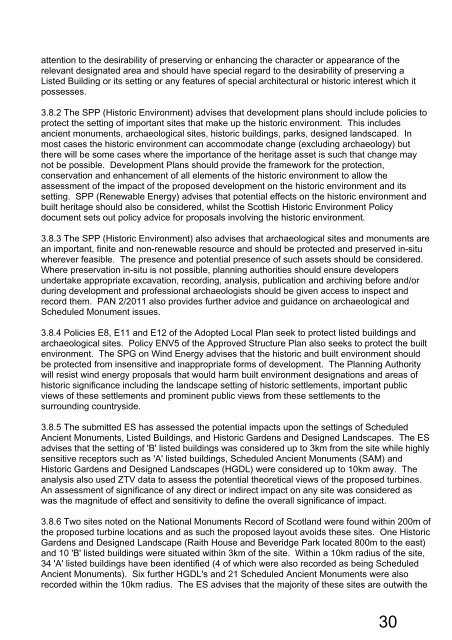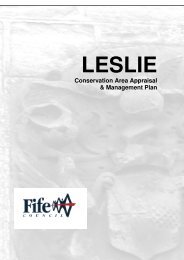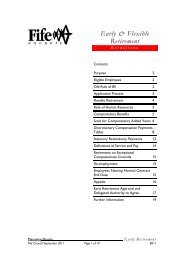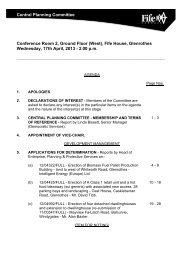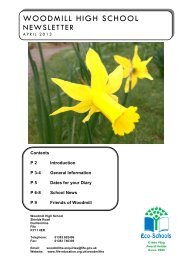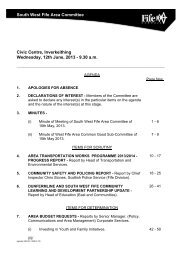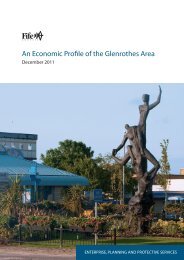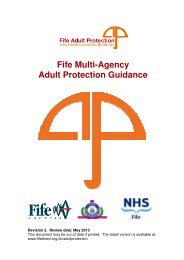the fife council - planning committee - glenrothes - Home Page
the fife council - planning committee - glenrothes - Home Page
the fife council - planning committee - glenrothes - Home Page
You also want an ePaper? Increase the reach of your titles
YUMPU automatically turns print PDFs into web optimized ePapers that Google loves.
attention to <strong>the</strong> desirability of preserving or enhancing <strong>the</strong> character or appearance of <strong>the</strong>relevant designated area and should have special regard to <strong>the</strong> desirability of preserving aListed Building or its setting or any features of special architectural or historic interest which itpossesses.3.8.2 The SPP (Historic Environment) advises that development plans should include policies toprotect <strong>the</strong> setting of important sites that make up <strong>the</strong> historic environment. This includesancient monuments, archaeological sites, historic buildings, parks, designed landscaped. Inmost cases <strong>the</strong> historic environment can accommodate change (excluding archaeology) but<strong>the</strong>re will be some cases where <strong>the</strong> importance of <strong>the</strong> heritage asset is such that change maynot be possible. Development Plans should provide <strong>the</strong> framework for <strong>the</strong> protection,conservation and enhancement of all elements of <strong>the</strong> historic environment to allow <strong>the</strong>assessment of <strong>the</strong> impact of <strong>the</strong> proposed development on <strong>the</strong> historic environment and itssetting. SPP (Renewable Energy) advises that potential effects on <strong>the</strong> historic environment andbuilt heritage should also be considered, whilst <strong>the</strong> Scottish Historic Environment Policydocument sets out policy advice for proposals involving <strong>the</strong> historic environment.3.8.3 The SPP (Historic Environment) also advises that archaeological sites and monuments arean important, finite and non-renewable resource and should be protected and preserved in-situwherever feasible. The presence and potential presence of such assets should be considered.Where preservation in-situ is not possible, <strong>planning</strong> authorities should ensure developersundertake appropriate excavation, recording, analysis, publication and archiving before and/orduring development and professional archaeologists should be given access to inspect andrecord <strong>the</strong>m. PAN 2/2011 also provides fur<strong>the</strong>r advice and guidance on archaeological andScheduled Monument issues.3.8.4 Policies E8, E11 and E12 of <strong>the</strong> Adopted Local Plan seek to protect listed buildings andarchaeological sites. Policy ENV5 of <strong>the</strong> Approved Structure Plan also seeks to protect <strong>the</strong> builtenvironment. The SPG on Wind Energy advises that <strong>the</strong> historic and built environment shouldbe protected from insensitive and inappropriate forms of development. The Planning Authoritywill resist wind energy proposals that would harm built environment designations and areas ofhistoric significance including <strong>the</strong> landscape setting of historic settlements, important publicviews of <strong>the</strong>se settlements and prominent public views from <strong>the</strong>se settlements to <strong>the</strong>surrounding countryside.3.8.5 The submitted ES has assessed <strong>the</strong> potential impacts upon <strong>the</strong> settings of ScheduledAncient Monuments, Listed Buildings, and Historic Gardens and Designed Landscapes. The ESadvises that <strong>the</strong> setting of 'B' listed buildings was considered up to 3km from <strong>the</strong> site while highlysensitive receptors such as 'A' listed buildings, Scheduled Ancient Monuments (SAM) andHistoric Gardens and Designed Landscapes (HGDL) were considered up to 10km away. Theanalysis also used ZTV data to assess <strong>the</strong> potential <strong>the</strong>oretical views of <strong>the</strong> proposed turbines.An assessment of significance of any direct or indirect impact on any site was considered aswas <strong>the</strong> magnitude of effect and sensitivity to define <strong>the</strong> overall significance of impact.3.8.6 Two sites noted on <strong>the</strong> National Monuments Record of Scotland were found within 200m of<strong>the</strong> proposed turbine locations and as such <strong>the</strong> proposed layout avoids <strong>the</strong>se sites. One HistoricGardens and Designed Landscape (Raith House and Beveridge Park located 800m to <strong>the</strong> east)and 10 'B' listed buildings were situated within 3km of <strong>the</strong> site. Within a 10km radius of <strong>the</strong> site,34 'A' listed buildings have been identified (4 of which were also recorded as being ScheduledAncient Monuments). Six fur<strong>the</strong>r HGDL's and 21 Scheduled Ancient Monuments were alsorecorded within <strong>the</strong> 10km radius. The ES advises that <strong>the</strong> majority of <strong>the</strong>se sites are outwith <strong>the</strong>30


